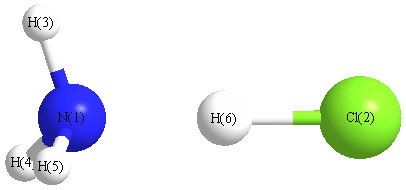Vibrational Frequencies calculated at HF/6-31+G**
| Mode Number |
Symmetry |
Frequency
(cm-1) |
Scaled Frequency
(cm-1) |
IR Intensities
(km mol-1) |
Raman Act
(Å4/u) |
Dep P |
Dep U |
|---|
| 1 |
A1 |
3707 |
3351 |
1.39 |
115.16 |
0.02 |
0.03 |
| 2 |
A1 |
2822 |
2552 |
947.21 |
379.42 |
0.32 |
0.48 |
| 3 |
A1 |
1193 |
1079 |
242.65 |
0.88 |
0.72 |
0.84 |
| 4 |
A1 |
162 |
147 |
8.40 |
0.81 |
0.27 |
0.43 |
| 5 |
E |
3846 |
3477 |
17.32 |
51.24 |
0.75 |
0.86 |
| 5 |
E |
3846 |
3477 |
17.32 |
51.24 |
0.75 |
0.86 |
| 6 |
E |
1798 |
1626 |
32.62 |
5.03 |
0.75 |
0.86 |
| 6 |
E |
1798 |
1626 |
32.62 |
5.03 |
0.75 |
0.86 |
| 7 |
E |
666 |
602 |
97.83 |
0.44 |
0.75 |
0.86 |
| 7 |
E |
666 |
602 |
97.83 |
0.44 |
0.75 |
0.86 |
| 8 |
E |
235 |
212 |
18.60 |
0.73 |
0.75 |
0.86 |
| 8 |
E |
235 |
212 |
18.60 |
0.73 |
0.75 |
0.86 |
Unscaled Zero Point Vibrational Energy (zpe) 10486.3 cm
-1
Scaled (by 0.9042) Zero Point Vibrational Energy (zpe) 9481.7 cm
-1
See section
III.C.1 List or set vibrational scaling factors
to change the scale factors used here.
See section
III.C.2
Calculate a vibrational scaling factor for a given set of molecules
to determine the least squares best scaling factor.
Charges, Dipole, Quadrupole and Polarizability
Charges from optimized geometry at HF/6-31+G**
Charges (e)
| Number |
Element |
Mulliken |
CHELPG |
AIM |
ESP |
| 1 |
N |
-0.933 |
|
|
|
| 2 |
Cl |
-0.252 |
|
|
|
| 3 |
H |
0.316 |
|
|
|
| 4 |
H |
0.316 |
|
|
|
| 5 |
H |
0.316 |
|
|
|
| 6 |
H |
0.238 |
|
|
|
Electric dipole moments
Electric dipole components in Debye
(What's a Debye? See section
VII.A.3)
| |
x |
y |
z |
Total |
| |
0.000 |
0.000 |
-4.342 |
4.342 |
| CHELPG |
|
|
|
|
| AIM |
|
|
|
|
| ESP |
|
|
|
|
Electric Quadrupole moment
Quadrupole components in D Å
| Primitive |
|---|
| | x | y | z |
|---|
| x |
-20.347 |
0.000 |
0.000 |
| y |
0.000 |
-20.347 |
0.000 |
| z |
0.000 |
0.000 |
-15.682 |
|
| Traceless |
|---|
| | x | y | z |
|---|
| x |
-2.332 |
0.000 |
0.000 |
| y |
0.000 |
-2.332 |
0.000 |
| z |
0.000 |
0.000 |
4.665 |
|
| Polar |
|---|
| 3z2-r2 | 9.329 |
|---|
| x2-y2 | 0.000 |
|---|
| xy | 0.000 |
|---|
| xz | 0.000 |
|---|
| yz | 0.000 |
|---|
|
Polarizabilities
Components of the polarizability tensor.
Units are
Å
3 (Angstrom cubed)
Change units.
| |
x |
y |
z |
| x |
2.676 |
0.000 |
0.000 |
| y |
0.000 |
2.676 |
0.000 |
| z |
0.000 |
0.000 |
4.320 |
<r2> (average value of r
2) Å
2
| <r2> |
86.639 |
| (<r2>)1/2 |
9.308 |
